Nadezda Chernyavskaya
CaloChallenge 2022: A Community Challenge for Fast Calorimeter Simulation
Oct 28, 2024
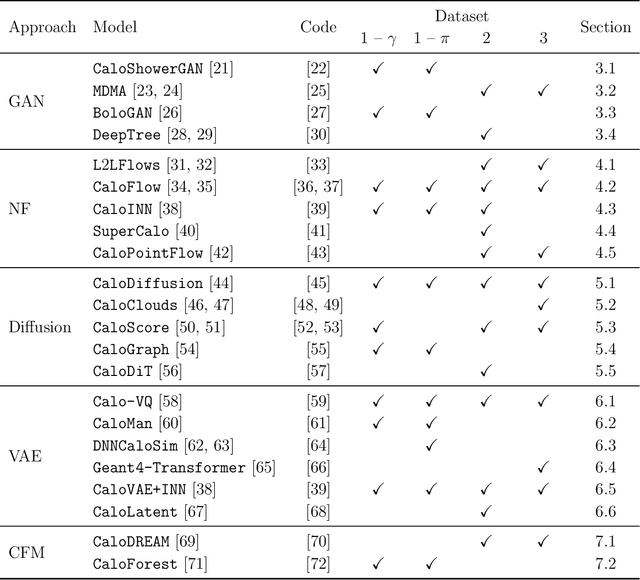
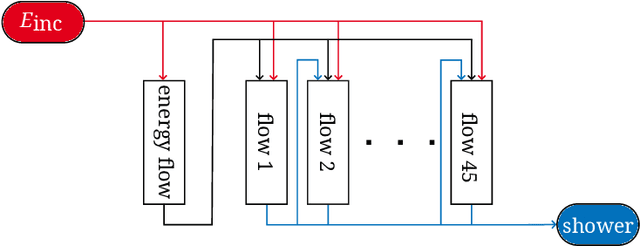
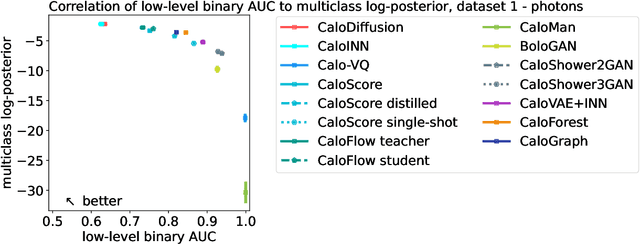
Abstract:We present the results of the "Fast Calorimeter Simulation Challenge 2022" - the CaloChallenge. We study state-of-the-art generative models on four calorimeter shower datasets of increasing dimensionality, ranging from a few hundred voxels to a few tens of thousand voxels. The 31 individual submissions span a wide range of current popular generative architectures, including Variational AutoEncoders (VAEs), Generative Adversarial Networks (GANs), Normalizing Flows, Diffusion models, and models based on Conditional Flow Matching. We compare all submissions in terms of quality of generated calorimeter showers, as well as shower generation time and model size. To assess the quality we use a broad range of different metrics including differences in 1-dimensional histograms of observables, KPD/FPD scores, AUCs of binary classifiers, and the log-posterior of a multiclass classifier. The results of the CaloChallenge provide the most complete and comprehensive survey of cutting-edge approaches to calorimeter fast simulation to date. In addition, our work provides a uniquely detailed perspective on the important problem of how to evaluate generative models. As such, the results presented here should be applicable for other domains that use generative AI and require fast and faithful generation of samples in a large phase space.
Knowledge Distillation for Anomaly Detection
Oct 09, 2023


Abstract:Unsupervised deep learning techniques are widely used to identify anomalous behaviour. The performance of such methods is a product of the amount of training data and the model size. However, the size is often a limiting factor for the deployment on resource-constrained devices. We present a novel procedure based on knowledge distillation for compressing an unsupervised anomaly detection model into a supervised deployable one and we suggest a set of techniques to improve the detection sensitivity. Compressed models perform comparably to their larger counterparts while significantly reducing the size and memory footprint.
Autoencoders for Real-Time SUEP Detection
Jun 26, 2023Abstract:Confining dark sectors with pseudo-conformal dynamics can produce Soft Unclustered Energy Patterns, or SUEPs, at the Large Hadron Collider: the production of dark quarks in proton-proton collisions leading to a dark shower and the high-multiplicity production of dark hadrons. The final experimental signature is spherically-symmetric energy deposits by an anomalously large number of soft Standard Model particles with a transverse energy of a few hundred MeV. The dominant background for the SUEP search, if it gets produced via gluon-gluon fusion, is multi-jet QCD events. We have developed a deep learning-based Anomaly Detection technique to reject QCD jets and identify any anomalous signature, including SUEP, in real-time in the High-Level Trigger system of the Compact Muon Solenoid experiment at the Large Hadron Collider. A deep convolutional neural autoencoder network has been trained using QCD events by taking transverse energy deposits in the inner tracker, electromagnetic calorimeter, and hadron calorimeter sub-detectors as 3-channel image data. To tackle the biggest challenge of the task, due to the sparse nature of the data: only ~0.5% of the total ~300 k image pixels have non-zero values, a non-standard loss function, the inverse of the so-called Dice Loss, has been exploited. The trained autoencoder with learned spatial features of QCD jets can detect 40% of the SUEP events, with a QCD event mistagging rate as low as 2%. The model inference time has been measured using the Intel CoreTM i5-9600KF processor and found to be ~20 ms, which perfectly satisfies the High-Level Trigger system's latency of O(100) ms. Given the virtue of the unsupervised learning of the autoencoders, the trained model can be applied to any new physics model that predicts an experimental signature anomalous to QCD jets.
Triggering Dark Showers with Conditional Dual Auto-Encoders
Jun 22, 2023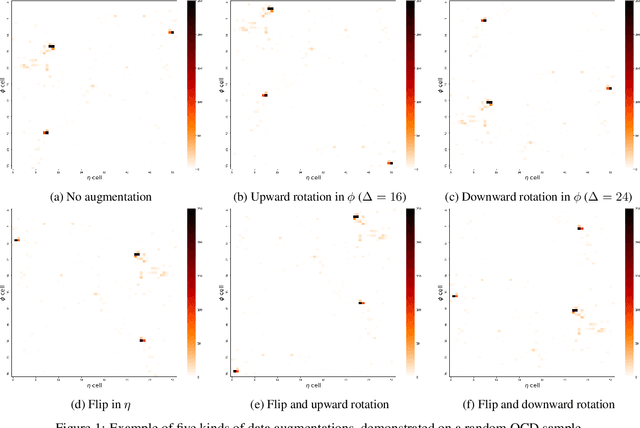
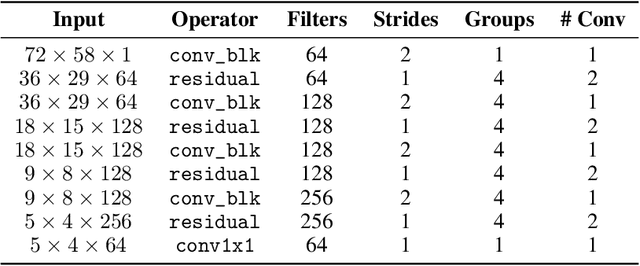
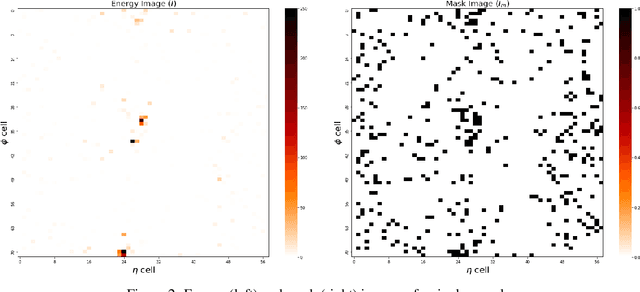
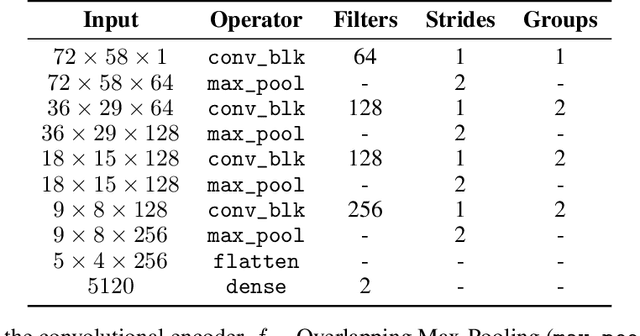
Abstract:Auto-encoders (AEs) have the potential to be effective and generic tools for new physics searches at colliders, requiring little to no model-dependent assumptions. New hypothetical physics signals can be considered anomalies that deviate from the well-known background processes generally expected to describe the whole dataset. We present a search formulated as an anomaly detection (AD) problem, using an AE to define a criterion to decide about the physics nature of an event. In this work, we perform an AD search for manifestations of a dark version of strong force using raw detector images, which are large and very sparse, without leveraging any physics-based pre-processing or assumption on the signals. We propose a dual-encoder design which can learn a compact latent space through conditioning. In the context of multiple AD metrics, we present a clear improvement over competitive baselines and prior approaches. It is the first time that an AE is shown to exhibit excellent discrimination against multiple dark shower models, illustrating the suitability of this method as a performant, model-independent algorithm to deploy, e.g., in the trigger stage of LHC experiments such as ATLAS and CMS.
Lorentz Group Equivariant Autoencoders
Dec 14, 2022Abstract:There has been significant work recently in developing machine learning models in high energy physics (HEP), for tasks such as classification, simulation, and anomaly detection. Typically, these models are adapted from those designed for datasets in computer vision or natural language processing without necessarily incorporating inductive biases suited to HEP data, such as respecting its inherent symmetries. Such inductive biases can make the model more performant and interpretable, and reduce the amount of training data needed. To that end, we develop the Lorentz group autoencoder (LGAE), an autoencoder model equivariant with respect to the proper, orthochronous Lorentz group $\mathrm{SO}^+(3,1)$, with a latent space living in the representations of the group. We present our architecture and several experimental results on jets at the LHC and find it significantly outperforms a non-Lorentz-equivariant graph neural network baseline on compression and reconstruction, and anomaly detection. We also demonstrate the advantage of such an equivariant model in analyzing the latent space of the autoencoder, which can have a significant impact on the explainability of anomalies found by such black-box machine learning models.
On the Evaluation of Generative Models in High Energy Physics
Nov 18, 2022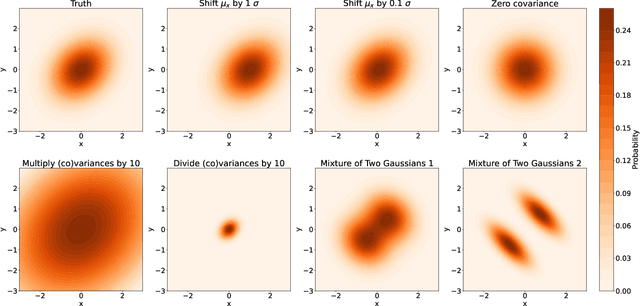
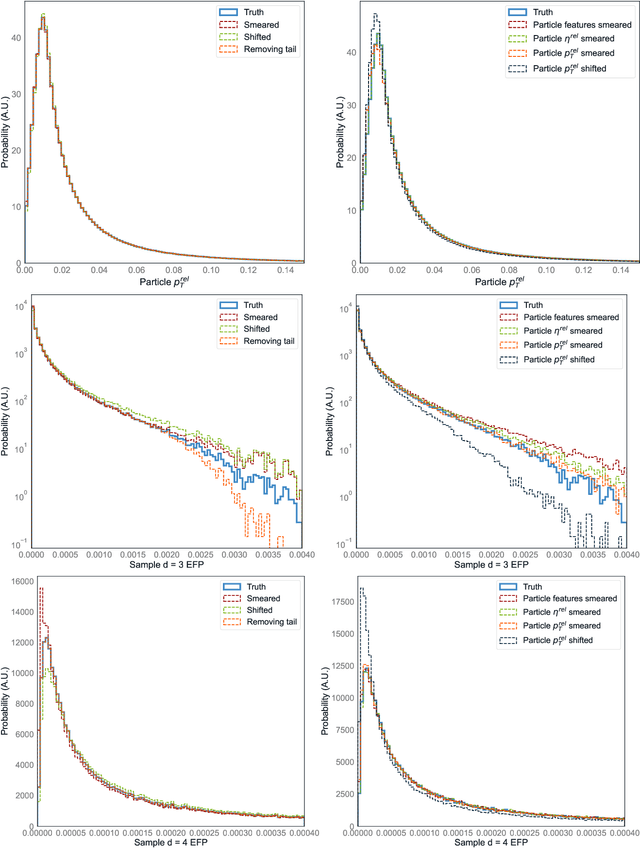
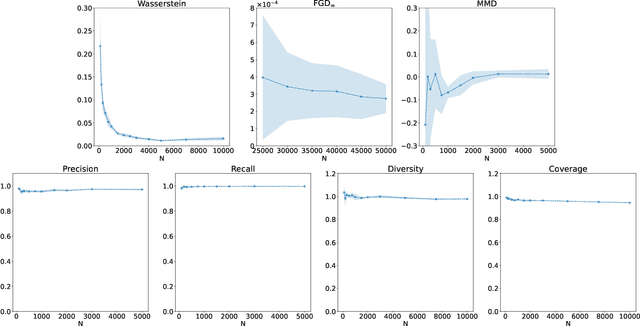
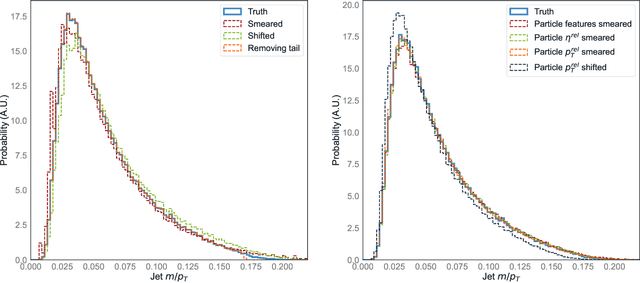
Abstract:There has been a recent explosion in research into machine-learning-based generative modeling to tackle computational challenges for simulations in high energy physics (HEP). In order to use such alternative simulators in practice, we need well defined metrics to compare different generative models and evaluate their discrepancy from the true distributions. We present the first systematic review and investigation into evaluation metrics and their sensitivity to failure modes of generative models, using the framework of two-sample goodness-of-fit testing, and their relevance and viability for HEP. Inspired by previous work in both physics and computer vision, we propose two new metrics, the Fr\'echet and kernel physics distances (FPD and KPD), and perform a variety of experiments measuring their performance on simple Gaussian-distributed, and simulated high energy jet datasets. We find FPD, in particular, to be the most sensitive metric to all alternative jet distributions tested and recommend its adoption, along with the KPD and Wasserstein distances between individual feature distributions, for evaluating generative models in HEP. We finally demonstrate the efficacy of these proposed metrics in evaluating and comparing a novel attention-based generative adversarial particle transformer to the state-of-the-art message-passing generative adversarial network jet simulation model.
End-to-end multi-particle reconstruction in high occupancy imaging calorimeters with graph neural networks
Apr 14, 2022



Abstract:We present an end-to-end reconstruction algorithm to build particle candidates from detector hits in next-generation granular calorimeters similar to that foreseen for the high-luminosity upgrade of the CMS detector. The algorithm exploits a distance-weighted graph neural network, trained with object condensation, a graph segmentation technique. Through a single-shot approach, the reconstruction task is paired with energy regression. We describe the reconstruction performance in terms of efficiency as well as in terms of energy resolution. In addition, we show the jet reconstruction performance of our method and discuss its inference computational cost. To our knowledge, this work is the first-ever example of single-shot calorimetric reconstruction of ${\cal O}(1000)$ particles in high-luminosity conditions with 200 pileup.
Particle-based Fast Jet Simulation at the LHC with Variational Autoencoders
Mar 01, 2022
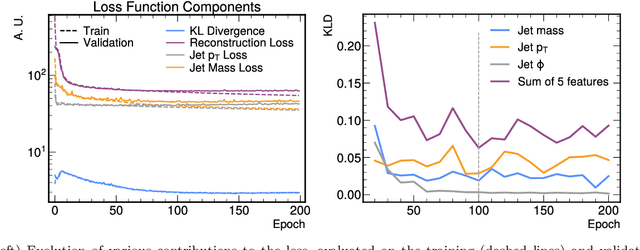

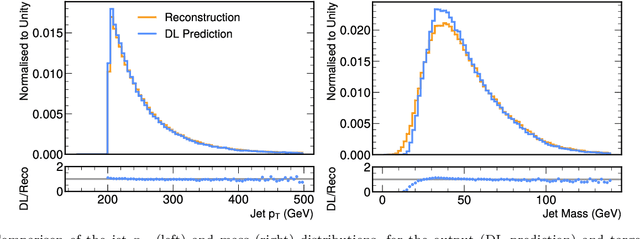
Abstract:We study how to use Deep Variational Autoencoders for a fast simulation of jets of particles at the LHC. We represent jets as a list of constituents, characterized by their momenta. Starting from a simulation of the jet before detector effects, we train a Deep Variational Autoencoder to return the corresponding list of constituents after detection. Doing so, we bypass both the time-consuming detector simulation and the collision reconstruction steps of a traditional processing chain, speeding up significantly the events generation workflow. Through model optimization and hyperparameter tuning, we achieve state-of-the-art precision on the jet four-momentum, while providing an accurate description of the constituents momenta, and an inference time comparable to that of a rule-based fast simulation.
 Add to Chrome
Add to Chrome Add to Firefox
Add to Firefox Add to Edge
Add to Edge